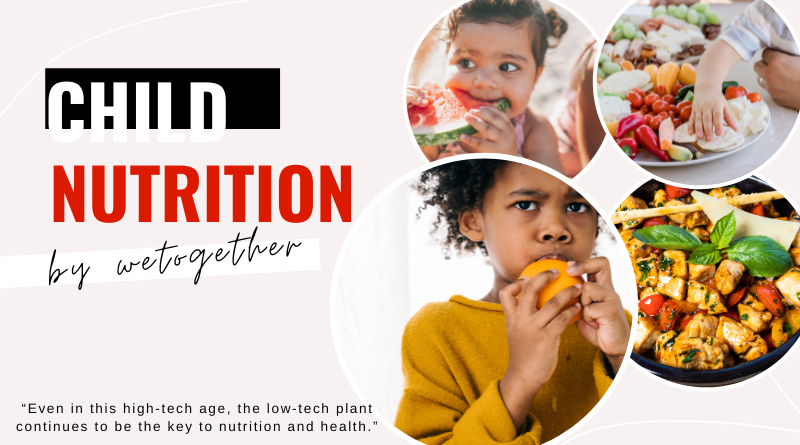Child Nutritional Requirements vary by age, gender, and activity level. Here’s a general overview of the key nutrients and food groups important for children’s development from infancy to adolescence:

Infants (0-12 months):
- Breast Milk or Formula: For infants, breast milk or formula is the primary source of nutrition during the first six months of life. Breast milk is recommended due to its numerous health benefits.
- Iron-Fortified Cereals: Around 6 months, introduce iron-fortified cereals to meet the growing iron needs.
- Pureed Fruits and Vegetables: Introduce pureed or mashed fruits and vegetables to provide vitamins, minerals, and fiber.
- Protein: After around 6 months, introduce pureed or mashed meats, fish, and legumes for protein.
- Dairy: After the age of one, you can introduce whole cow’s milk, yogurt, and cheese. Continue breastfeeding or formula as appropriate.
Toddlers (1-3 years):

- Fruits and Vegetables: Provide a variety of fruits and vegetables for essential vitamins and fiber.
- Whole Grains: Offer whole-grain bread, pasta, and cereals for energy and fiber.
- Protein: Include lean meats, poultry, fish, eggs, legumes, and dairy products for protein and calcium.
- Dairy: Continue offering whole milk and dairy products for calcium.
- Healthy Fats: Avocado, nuts, seeds, and olive oil can provide essential fats for brain development.
- Limit Added Sugars and Processed Foods: Minimize the consumption of sugary snacks and processed foods.
Preschool and School-Aged Children (4-18 years):
- Fruits and Vegetables: Encourage a variety of colorful fruits and vegetables for vitamins and minerals.
- Whole Grains: Provide whole grains for energy and fiber.
- Protein: Include lean meats, poultry, fish, eggs, legumes, and low-fat dairy products for protein and calcium.
- Healthy Fats: Continue to include healthy fats like avocado, nuts, seeds, and olive oil.
- Limit Sugary Drinks: Encourage water and limit sugary drinks.
- Hydration: Ensure your child drinks plenty of water throughout the day.
- Snacks: Offer healthy snacks like yogurt, cut-up fruits and vegetables, and whole-grain crackers. Limit sugary snacks and processed foods.
- Model Healthy Eating: Children often learn by example, so model healthy eating habits yourself.
- Portion Control: Pay attention to portion sizes, as children have smaller stomachs.
- Supplements: In most cases, a well-balanced diet should provide all necessary vitamins and minerals. Consult with a pediatrician before considering any supplements.
Remember that individual children may have different dietary needs, and it’s important to consult with a healthcare provider or a registered dietitian to tailor a diet to meet specific requirements. Additionally, it’s crucial to be aware of any allergies or dietary restrictions your child may have when planning their meals.
Nutritional Requirements For 7-10 Year Olds: What To Eat
Nutritional requirements for 8-10-year-olds are crucial for their growth and development. During this stage, children need a balanced diet that provides them with the necessary nutrients for physical and cognitive growth. Here’s a general guideline for what to include in their diet:

- Fruits and Vegetables: Encourage a variety of colorful fruits and vegetables in their diet. These are rich in vitamins, minerals, and fiber. Aim for at least 5 servings a day.
- Protein: Protein is essential for growth and muscle development. Good sources include lean meats, poultry, fish, eggs, dairy products, legumes (beans, lentils, and peas), and nuts.
- Whole Grains: Choose whole grains like whole wheat bread, brown rice, whole grain pasta, and oats. These provide essential fiber and energy for growing bodies.
- Dairy or Dairy Alternatives: Milk, yogurt, and cheese provide calcium and vitamin D, important for bone health. If your child is lactose intolerant, look for fortified dairy alternatives like almond or soy milk.
- Fats: Healthy fats are essential for brain development. Include sources like avocados, nuts, seeds, and olive oil in their diet. Limit saturated and trans fats, found in processed and fried foods.
- Hydration: Encourage your child to drink plenty of water throughout the day. Limit sugary drinks like soda and fruit juices.
- Snacks: Offer nutritious snacks like yogurt, cut-up fruits and vegetables, and whole-grain crackers. Limit sugary snacks and processed foods.
- Sweets and Treats: It’s okay for kids to enjoy sweets in moderation. Try to limit their intake of sugary snacks and desserts.
- Portion Control: Pay attention to portion sizes. Children have smaller stomachs, so appropriate portion sizes are important.
- Vitamins and Supplements: In most cases, a well-balanced diet should provide all the necessary vitamins and minerals. Consult with a pediatrician before considering any supplements.
- Meal Schedule: Establish regular meal and snack times to provide structure and help prevent overeating. A consistent eating schedule can also help with maintaining energy levels and focus.
- Model Healthy Eating: Children often learn by example, so try to model healthy eating habits yourself.
It’s important to remember that individual children may have different dietary needs, and consulting with a pediatrician or a registered dietitian can be helpful in tailoring a diet to meet specific requirements. Additionally, it’s crucial to be aware of any allergies or dietary restrictions your child may have when planning their meals.
Sample Nutrition Chart for Kids:
Note: This is a sample and can be adjusted to suit individual preferences and dietary restrictions.
Creating a nutrition chart for kids can be a helpful way to ensure they are getting a balanced diet. Below is a sample nutrition chart for children that provides a general guideline. Keep in mind that individual needs can vary, and consulting with a pediatrician or a registered dietitian is recommended for personalized guidance.

Breakfast:
- Whole-grain cereal with low-fat milk or fortified dairy-free milk
- Sliced strawberries or banana
- Whole-grain toast with almond butter or peanut butter
Morning Snack:
- Baby carrots and cucumber slices with hummus
- A small piece of cheese
- Water or a small portion of 100% fruit juice (in moderation)
Lunch:
- Grilled chicken or tofu and vegetable wrap in a whole-grain tortilla
- Cherry tomatoes and bell pepper strips
- Low-fat yogurt or dairy-free yogurt
- Water or milk
Afternoon Snack:
- Sliced apple or pear
- Celery sticks with cream cheese or nut butter
- Water or a small portion of 100% fruit juice (in moderation)
Dinner:
- Baked or grilled salmon or a plant-based protein source (like lentils or chickpeas)
- Steamed broccoli and carrots
- Brown rice or whole-grain pasta
- Water or milk
Evening Snack (if needed):
- A small serving of low-sugar, whole-grain cereal with milk or a dairy-free alternative
- Sliced grapes or a small banana
- Water
General Tips:
- Encourage your child to drink water throughout the day.
- Limit sugary snacks, sugary drinks, and processed foods.
- Promote portion control to prevent overeating.
- Model healthy eating habits by eating balanced meals with your child.
- Consider any dietary restrictions, allergies, or specific preferences your child may have.
Remember that a nutrition chart should be flexible and adapted to your child’s specific dietary needs, activity level, and preferences. It’s also important to encourage a positive attitude toward food and mealtimes and to involve your child in making healthy food choices. Additionally, consulting with a healthcare provider or a registered dietitian can help you create a personalized nutrition plan for your child.


